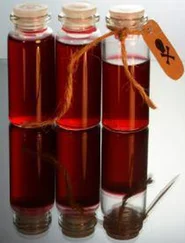When Morgan spoke, it was again with the Devil’s voice. Blood now was running down the sides of chair, pooling on the ground. She laughed. “Take joy in my momentary pain,” she said. “For the blood of my death shall be the ocean by which we sail and you, my dear Reverend Hawthorne… your lineage shall be the vessel by which the Master completes his journey!”
“I shall have nothing to do with you,” hissed Hawthorne. “Nor shall my heirs.”
Morgan smiled in a disjointed, hideous way. “No, Hawthorne,” she said. “We shall be Salem’s everlasting plague.”
These last words she repeated and then repeated again, Salem’s everlasting plague, Salem’s everlasting plague , the words said over and over again to become first a chant and then a kind of drone. Hawthorne struggled with the helmet. A wind rushed through the room again and the witches were suddenly ungagged, their screams joining the whistling of the wind. With a snap he managed to open the helmet. It split along a hinge in the middle, separating into two halves.
He stood and rushed to the chair, securing the back half of the helmet behind Morgan’s head. Despite Virgil’s death, despite Dean weeping and holding his brother and apparently unable to be of use, he felt at last hopeful. The end of the nightmare was in sight. He drew himself straight and fumbled to get the front half of the helmet into place. Morgan’s chant was a distraction.
“Recite as you wish,” he said. “There is no escape from the true Word of God! There is no resurrection from the pits of Hell!”
And then he had it right and had closed it over Morgan’s face. He slid the iron hasp into place to lock it closed.
Behind him, all the witches shouted, as if one: “Satan’s everlasting plague!”
“So be it that under our blessed God we are judge, jury, and executioner this night. Set the fires… Purify Salem from this curse!” shouted Hawthorne.
But Dean still stayed bent over his brother, holding his body.
“Dean!” shouted Hawthorne. “For God’s sake, the fires!”
The bearlike man seemed to suddenly come to himself. He let his brother fall gently to the floor and lumbered toward one of the torch sconces. He grabbed a torch and trailed it along the trough. The tinder caught flame, a wall of fire quickly spreading down the trough. The witches began screaming, a veritable symphony of agony as the flesh of their legs burned and bubbled. The smell of burning flesh filled the air.
The wind began to rise again. “The nails!” Hawthorne shouted.
Mather stepped forward. In his hands he held five metal spikes and a wooden mallet. Hawthorne grabbed hold of one of the spikes and the mallet. One by one he drove the spikes through the openings in the mask.
He drove them into the eyes first, pounding them just far enough to blind Morgan and lodge them painfully in her sockets. Her body thrashed awkwardly, the veins standing out on her neck, her head immobilized. Then he drove one into the left side of her forehead. The spike, he knew, would tear away the flesh on the side of her temple and slowly gouge through the bone and then slip painfully along the exposed brain, tearing the tissue there just a little. The spike into the right side of her forehead would do the same, and the two together would reduce the little movement she had within the mask to nothing. Her body continued to thrash and her muffled screams echoed inside the helmet. It was terrible to hear, but never before had Hawthorne been so convinced that God’s will was being fulfilled.
Perhaps now, now that the pain was so great, if asked to renounce Satan and his minions she would do so, Hawthorne couldn’t help but think. But no, a sterner and more severe part of him thought. She had had her chance. Now it was too late for her. God’s mercy would not be granted her.
Ignoring both Morgan’s screams and the shrieks of the burning witches behind him, ignoring the stink of burning flesh and the smoke billowing up the chimney, Hawthorne positioned the final spike in the hole in the center of the forehead.
“You have sold your soul to the Devil,” he said. “And to the Devil you shall now go.”
He waited the briefest moment and then slammed the mallet hard onto the head of the spike, driving it deep through the bone and into the witch’s head. Blood gushed uncontrollably through the holes in the mask and Morgan’s body began to thrash violently, and then suddenly she fell still.
Dead at last , thought Hawthorne, and he turned away, trying not to think of her final threats toward him and his children. What had she meant that they would be Salem’s everlasting plague? No, best not to think about it, he told himself. These were the rantings of a deranged woman in fear of death. Just as before, as always, God had protected him. God would continue to protect them, he thought, and tried not to look at Virgil’s corpse. He told himself, not altogether convincingly, that they had nothing to fear.
PART TWO
SALEM, MASSACHUSETTS
PRESENT DAY
Monday
Chapter Seven
The town of Salem had changed much over the years, the dirt paths and wagon tracks replaced now by paved roads. The waterfront, once so bustling and lively with the spice trade, was now filled with shops for the tourists who came to Salem year-round, interested in the town’s past. The only three-master in the harbor was a replica and was now a museum. There were still a few fishing boats, but the majority of the trade had moved a little way away, to the more commercial town of Gloucester. The customhouse that Hawthorne had once worked in was still there, a stately redbrick building with white pillars that resembled a schoolhouse. Near where the witches had been killed was now a paved pedestrian downtown: tourist shops, witch museums, witch tours. Next to a cart selling hats and T-shirts, two women with tags reading “I’m a Wiccan” were prepared to answer any and all questions.
But just a few blocks away from the center of town, the character of Salem changed. The streets became quiet, the tourists all clinging to the waterfront and the museums downtown. Here, the neighborhoods were old and historic, the houses painted traditional slate blue or dark red. The newer ones were New England late Victorians, large, impressive structures that these days were often split into multiple apartments. But there were among them federal houses with mullioned windows and hipped roofs, with the facades covered in wide, flat board siding. Less common, but still present, were the earlier Georgian colonials, wooden and barnlike in structure, with gambreled roofs, flat fronts, and double-sashed windows. Rarer still were the old saltboxes from the colony’s early years, high on one side and low on the other, with very few windows, and these filled with a series of small diamond-shaped panes. On these streets, you could see the whole history of Salem’s past and imagine the original colonizer standing shoulder to shoulder with their descendants, and could even convince yourself, if you were standing in the right place, before the right house, that the past was not past after all.
There was little about the house on the outside to suggest what Heidi Hawthorne’s apartment looked like on the inside, or to give any clue to the kind of person she was. Outside it seemed a typical mid-Victorian house on a quaint street in this perfectly maintained and varied historic neighborhood, though this particular house was slightly less perfectly maintained than the others around it. The white paint had faded and the drab green shutters gave the house a less vibrant feel than the others. It wouldn’t be long before the paint started to peel and the landlord would be paid a visit from the Salem Historical Society, reminding her that a responsibility to the community came with owning a historical home and encouraging her to properly maintain it unless she wanted a fine.
Читать дальше












